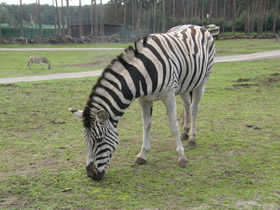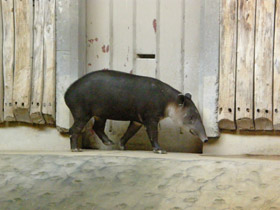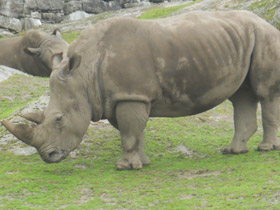The order Perissodactyla
Perissodactyla (/pəˌrɪsoʊˈdæktɪlə/, from Ancient Greek περισσός, perissós 'odd', and δάκτυλος, dáktylos 'finger, toe') is an order of ungulates. The order includes about 17 living species divided into three families: Equidae (horses, asses, and zebras), Rhinocerotidae (rhinoceroses), and Tapiridae (tapirs). They typically have reduced the weight-bearing toes to three or one of the five original toes, though tapirs retain four toes on their front feet. The nonweight-bearing toes are either present, absent, vestigial, or positioned posteriorly. By contrast, artiodactyls (even-toed ungulates) bear most of their weight equally on four or two (an even number) of the five toes: their third and fourth toes. Another difference between the two is that odd-toed ungulates digest plant cellulose in their intestines, rather than in one or more stomach chambers as even-toed ungulates, with the exception of Suina, do.
The order was considerably more diverse in the past, with notable extinct groups include the brontotheres, palaeotheres, chalicotheres, and the paraceratheres, with the paraceratheres including the largest known land mammals to have ever existed.
Despite their very different appearances, they were recognized as related families in the 19th century by the zoologist Richard Owen, who also coined the order's name.
Description
The list of the Perissodactyla includes such dissimilar animals as graceful horses, funny tapirs and heavy-set rhinos. So what do they have in common? Firstly, all of these animals eat grass, so their molars have transverse and longitudinal ridges on the chewing surface and are well adapted to grinding hard plant food. Secondly, Perissodactyla have a similar limb structure: an odd number of toes protected by special horny formations - hooves. Third, all Perissodactyla are characterised by a simple single-chambered stomach and a very long intestine.
Differences from parnopods
In the course of evolution, Perissodactyla faced competition from another group of herbivorous animals, the parnochaetes, and they seem to have lost this war. Both have a "fermentation chamber" in their digestive tract where symbiotic microorganisms further ferment the chewed grass, but in parnochaetes it is the rumen at the front of the stomach, while in Perissodactyla it is the blind intestine behind it. The former digest food slowly and leisurely, extracting from it as much as possible, the latter, on the contrary, run the grass mass through the stomach with extreme speed. The digestion of Perissodactyla was less productive, which was probably one of the reasons for their displacement by Artiodactyla and subsequent extinction. The low rate of reproduction characteristic of these animals also contributed to this. Perissodactyla reach sexual maturity late, are characterised by a long gestation period and few offspring: the female usually gives birth to only one calf (however, a few hours after birth it is able to follow the mother) and feeds it with milk for at least a year. Anyway, out of 600 species of Perissodactyla belonging to 12 families, only 16 species from 3 families have survived to our days, and many of them are so rare that they are included in the International Red Data Book. All Perissodactyla are large or very large terrestrial mammals with body lengths from 180 to 420 cm and weights from 150 to 3,500 kg.
Anatomy
The largest odd-toed ungulates are rhinoceroses, and the extinct Paraceratherium, a hornless rhino from the Oligocene, is considered one of the largest land mammals of all time. At the other extreme, an early member of the order, the prehistoric horse Eohippus, had a withers height of only 30 to 60 cm (12 to 24 in). Apart from dwarf varieties of the domestic horse and donkey, living perissodactyls reach a body length of 180–420 cm (71–165 in) and a weight of 150 to 4,500 kg (330 to 9,920 lb). While rhinos have only sparse hair and exhibit a thick epidermis, tapirs and horses have dense, short coats. Most species are grey or brown, although zebras and young tapirs are striped.
Distribution
Most extant perissodactyl species occupy a small fraction of their original range. Members of this group are now found only in Central and South America, eastern and southern Africa, and central, southern, and southeastern Asia. During the peak of odd-toed ungulate existence, from the Eocene to the Oligocene, perissodactyls were distributed over much of the globe, the major exceptions being Australia and Antarctica. Horses and tapirs arrived in South America after the formation of the Isthmus of Panama around 3 million years ago in the Pliocene. Their North American counterparts died out around 10,000 years ago, leaving only Baird`s tapir with a range extending to what is now southern Mexico. The tarpans were pushed to extinction in 19th century Europe. Hunting and habitat destruction have reduced the surviving perissodactyl species to fragmented populations. In contrast, domesticated horses and donkeys have gained a worldwide distribution, and feral animals of both species are now also found in regions outside their original range, such as in Australia.
Lifestyle and diet
Perissodactyls inhabit a number of different habitats, leading to different lifestyles. Tapirs are solitary and inhabit mainly tropical rainforests. Rhinos tend to live alone in rather dry savannas, and in Asia, wet marsh or forest areas. Horses inhabit open areas such as grasslands, steppes, or semi-deserts, and live together in groups. Odd-toed ungulates are exclusively herbivores that feed, to varying degrees, on grass, leaves, and other plant parts. A distinction is often made between primarily grass feeders (white rhinos, equines) and leaf feeders (tapirs, other rhinos).
Reproduction and development
Odd-toed ungulates are characterized by a long gestation period and a small litter size, usually delivering a single young. The gestation period is 330–500 days, being longest in rhinos. Newborn perissodactyls are precocial, meaning offspring are born already quite independent: for example, young horses can begin to follow the mother after a few hours. The young are nursed for a relatively long time, often into their second year, reaching sexual maturity around eight or ten years old. Perissodactyls are long-lived, with several species, such as rhinos, reaching an age of almost 50 years in captivity.
Taxonomy
Traditionally, the odd-toed ungulates were classified with other mammals such as artiodactyls, hyraxes, elephants and other "ungulates". A close family relationship with hyraxes was suspected based on similarities in the construction of the ear and the course of the carotid artery.
Odd-toed ungulates (Perissodactyla) comprise three living families with around 17 species—in horses, however, the exact count is still controversial. Rhinos and tapirs are more closely related to each other than to horses. The separation of horses from other perissodactyls took place according to molecular genetic analysis in the Paleocene some 56 million years ago, while the rhinos and tapirs split off in the lower-middle Eocene, about 47 million years ago.
Order Perissodactyla:
- Suborder Hippomorpha:
- Family Equidae: horses and allies, seven species in one genus:
- Equus ferus;
- Tarpan, †Equus ferus ferus;
- Przewalski's horse, Equus ferus przewalskii;
- Domestic horse, Equus ferus caballus;
- African wild ass, Equus africanus;
- Nubian wild ass, Equus africanus africanus;
- Somali wild ass, Equus africanus somaliensis;
- Domesticated ass (donkey), Equus africanus asinus;
- Atlas wild ass, †Equus africanus atlanticus;
- Onager or Asiatic wild ass, Equus hemionus;
- Mongolian wild ass, Equus hemionus hemionus;
- Turkmenian kulan, Equus hemionus kulan;
- Persian onager, Equus hemionus onager;
- Indian wild ass, Equus hemionus khur;
- Syrian wild ass, †Equus hemionus hemippus;
- Kiang or Tibetan wild ass, Equus kiang;
- Western kiang, Equus kiang kiang;
- Eastern kiang, Equus kiang holdereri;
- Southern kiang, Equus kiang polyodon;
- Plains zebra, Equus quagga;
- Quagga, †Equus quagga quagga;
- Burchell's zebra, Equus quagga burchellii;
- Grant's zebra, Equus quagga boehmi;
- Maneless zebra, Equus quagga borensis;
- Chapman's zebra, Equus quagga chapmani;
- Crawshay's zebra, Equus quagga crawshayi;
- Selous' zebra, Equus quagga selousi;
- Mountain zebra, Equus zebra;
- Cape mountain zebra, Equus zebra zebra;
- Hartmann's mountain zebra, Equus zebra hartmannae;
- Grévy's zebra, Equus grevyi;
- Suborder Ceratomorpha:
- Family Tapiridae: tapirs, five species in one genus:
- Brazilian tapir, Tapirus terrestris;
- Mountain tapir, Tapirus pinchaque;
- Baird's tapir, Tapirus bairdii;
- Malayan tapir, Tapirus indicus;
- Kabomani tapir, Tapirus kabomani;
- Family Rhinocerotidae: rhinoceroses, five species in four genera;
- Black rhinoceros, Diceros bicornis;
- Southern black rhinoceros, †Diceros bicornis bicornis;
- North-eastern black rhinoceros, †Diceros bicornis brucii;
- Chobe black rhinoceros, Diceros bicornis chobiensis;
- Uganda black rhinoceros, Diceros bicornis ladoensis;
- Western black rhinoceros, †Diceros bicornis longipes;
- Eastern black rhinoceros, Diceros bicornis michaeli;
- South-central black rhinoceros, Diceros bicornis minor;
- South-western black rhinoceros, Diceros bicornis occidentalis;
- White rhinoceros, Ceratotherium simum;
- Southern white rhinoceros, Ceratotherium simum simum;
- Northern white rhinoceros, Ceratotherium simum cottoni;
- Indian rhinoceros, Rhinoceros unicornis;
- Javan rhinoceros, Rhinoceros sondaicus;
- Indonesian Javan rhinoceros, Rhinoceros sondaicus sondaicus;
- Vietnamese Javan rhinoceros, Rhinoceros sondaicus annamiticus;
- Indian Javan rhinoceros, †Rhinoceros sondaicus inermis;
- Sumatran rhinoceros, Dicerorhinus sumatrensis;
- Western Sumatran rhinoceros, Dicerorhinus sumatrensis sumatrensis;
- Eastern Sumatran rhinoceros, Dicerorhinus sumatrensis harrissoni;
- Northern Sumatran rhinoceros, †Dicerorhinus sumatrensis lasiotis.


















































